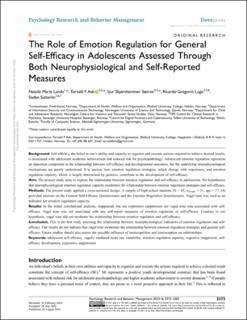| dc.contributor.author | Lande, Natalie Marie | |
| dc.contributor.author | Ask, Torvald Fossåen | |
| dc.contributor.author | Sætren, Sjur Skjørshammer | |
| dc.contributor.author | Lugo, Ricardo Gregorio | |
| dc.contributor.author | Sütterlin, Stefan | |
| dc.date.accessioned | 2023-11-01T07:31:08Z | |
| dc.date.available | 2023-11-01T07:31:08Z | |
| dc.date.created | 2023-07-31T19:16:58Z | |
| dc.date.issued | 2023 | |
| dc.identifier.citation | Psychology Research and Behavior Management. 2023, 16, 3373-3383. | en_US |
| dc.identifier.issn | 1179-1578 | |
| dc.identifier.uri | https://hdl.handle.net/11250/3099881 | |
| dc.description.abstract | Background: Self-efficacy, the belief in one’s ability and capacity to organize and execute actions required to achieve desired results, is associated with adolescent academic achievement and reduced risk for psychopathology. Adolescent emotion regulation represents an important component in the relationship between self-efficacy and developmental outcomes, but the underlying neurophysiological mechanisms are poorly understood. It is unclear how emotion regulation strategies, which change with experience, and emotion regulation capacity, which is largely determined by genetics, contribute to the development of self-efficacy.
Aim: The present study aims to explore the relationship between emotion regulation and self-efficacy in adolescents. We hypothesize that neurophysiological emotion regulation capacity moderates the relationship between emotion regulation strategies and self-efficacy.
Methods: The present study applied a cross-sectional design. A sample of high-school students (N = 45, nfemale = 31, age = 17– 18) provided answers on the General Self-Efficacy Questionnaire and the Emotion Regulation Questionnaire. Vagal tone was used as an indicator for emotion regulation capacity.
Results: In the initial correlational analysis, reappraisal, but not expressive suppression nor vagal tone was associated with self-efficacy. Vagal tone was not associated with any self-report measures of emotion regulation or self-efficacy. Contrary to our hypothesis, vagal tone did not moderate the relationship between emotion regulation and self-efficacy.
Conclusion: This is the first study assessing the relationship between neurophysiological indicators of emotion regulation and self-efficacy. Our results do not indicate that vagal tone moderates the relationship between emotion regulation strategies and general self-efficacy. Future studies should also assess the possible influence of metacognition and interoception on relationships. | en_US |
| dc.language.iso | eng | en_US |
| dc.publisher | Dove Medical Press Ltd. | en_US |
| dc.relation.uri | https://www.dovepress.com/articles.php?article_id=86184 | |
| dc.rights | Navngivelse-Ikkekommersiell 4.0 Internasjonal | * |
| dc.rights.uri | http://creativecommons.org/licenses/by-nc/4.0/deed.no | * |
| dc.subject | adolescent self-efficacy | en_US |
| dc.subject | vagally mediated heart rate variability | en_US |
| dc.subject | emotion regulation capacity | en_US |
| dc.subject | cognitive reappraisal | en_US |
| dc.subject | self-efficacy development | en_US |
| dc.subject | expressive suppression | en_US |
| dc.title | The Role of Emotion Regulation for General Self-Efficacy in Adolescents Assessed Through Both Neurophysiological and Self-Reported Measures | en_US |
| dc.type | Peer reviewed | en_US |
| dc.type | Journal article | en_US |
| dc.description.version | publishedVersion | en_US |
| dc.rights.holder | © 2023 Lande et al. | en_US |
| dc.subject.nsi | VDP::Samfunnsvitenskap: 200::Psykologi: 260 | en_US |
| dc.source.pagenumber | 3373-3383 | en_US |
| dc.source.volume | 16 | en_US |
| dc.source.journal | Psychology Research and Behavior Management | en_US |
| dc.identifier.doi | 10.2147/PRBM.S406702 | |
| dc.identifier.cristin | 2164149 | |
| cristin.ispublished | true | |
| cristin.fulltext | original | |
| cristin.qualitycode | 1 | |

